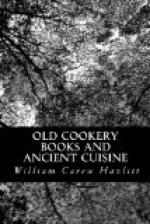A far more thorough conquest than that which the day of Hastings signalised was accomplished by an army of a more pacific kind, which crossed the Channel piecemeal, bringing in their hands, not bows and swords, but new dishes and new wines. These invaders of our soil were doubtless welcomed as benefactors by the proud nobles of the Courts of Edward II. and Richard II., as well as by Royalty itself; and the descriptions which have been preserved of the banquets held on special occasions in the fourteenth and fifteenth centuries, and even of the ordinary style of living of some, make our City feasts of to-day shrink into insignificance. But we must always remember that the extravagant luxury and hospitality of the old time were germane and proper to it, component parts of the social framework.
It is to be remarked that some of the most disturbed and disastrous epochs in our annals are those to which we have to go for records of the greatest exploits in gastronomy and lavish expenditure of public money on comparatively unprofitable objects. During the period from the accession of Rufus to the death of Henry III., and again under the rule of Richard II., the taste for magnificent parade and sumptuous entertainments almost reached its climax. The notion of improving the condition of the poor had not yet dawned on the mind of the governing class; to make the artizan and the operative self-supporting and self-respectful was a movement not merely unformulated, but a conception beyond the parturient faculty of a member of the Jacquerie. The king, prince, bishop, noble, of unawakened England met their constituents at dinner in a fashion once or twice in a lifetime, and when the guests below the salt had seen the ways of greatness, they departed to fulfil their several callings. These were political demonstrations with a clear and (for the age) not irrational object; but for the modern public dinner, over which I should be happy to preach the funeral sermon, there is not often this or any other plea.
The redistribution of wealth and its diversion into more fruitful channels has already done something for the people; and in the future that lies before some of us they will do vastly more. All Augaea will be flushed out.
In some of these superb feasts, such as that at the marriage of Henry IV. in 1403, there were two series of courses, three of meat, and three of fish and sweets; in which we see our present fashion to a certain extent reversed. But at the coronation of Henry V. in 1421, only three courses were served, and those mixed. The taste for what were termed “subtleties,” had come in, and among the dishes at this latter entertainment occur, “A pelican sitting on her nest with her young,” and “an image of St. Catherine holding a book and disputing with the doctors.” These vagaries became so common, that few dinners of importance were accounted complete without one or more.
One of the minor “subtleties” was a peacock in full panoply. The bird was first skinned, and the feathers, tail, head and neck having been laid on a table, and sprinkled with cummin, the body was roasted, glazed with raw egg-yolk, and after being left to cool, was sewn back again into the skin and so brought to table as the last course. In 1466, at the enthronement of Archbishop Nevile, no fewer than 104 peacocks were dressed.




